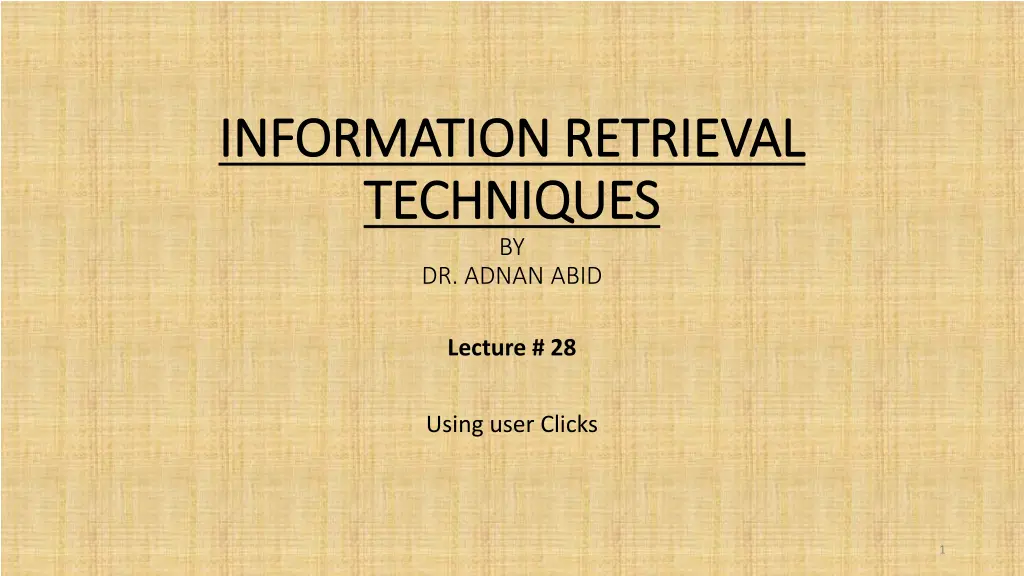
Information Retrieval Techniques Lecture Insights
Explore valuable insights from a lecture on information retrieval techniques, covering topics such as user clicks, relative vs. absolute ratings, pairwise preferences, and more. Uncover the significance of click data and its implications in assessing relevance for queries.
Download Presentation

Please find below an Image/Link to download the presentation.
The content on the website is provided AS IS for your information and personal use only. It may not be sold, licensed, or shared on other websites without obtaining consent from the author. If you encounter any issues during the download, it is possible that the publisher has removed the file from their server.
You are allowed to download the files provided on this website for personal or commercial use, subject to the condition that they are used lawfully. All files are the property of their respective owners.
The content on the website is provided AS IS for your information and personal use only. It may not be sold, licensed, or shared on other websites without obtaining consent from the author.
E N D
Presentation Transcript
INFORMATION RETRIEVAL INFORMATION RETRIEVAL TECHNIQUES TECHNIQUES BY DR. ADNAN ABID Lecture # 28 Using user Clicks 1
ACKNOWLEDGEMENTS ACKNOWLEDGEMENTS The presentation of this lecture has been taken from the underline sources 1. Introduction to information retrieval by Prabhakar Raghavan, Christopher D. Manning, and Hinrich Sch tze 2. Managing gigabytes by Ian H. Witten, Alistair Moffat, Timothy C. Bell 3. Modern information retrieval by Baeza-Yates Ricardo, 4. Web Information Retrieval by Stefano Ceri, Alessandro Bozzon, Marco Brambilla
Outline Outline What do clicks tell us? Relative vs absolute ratings Pairwise relative ratings Interleaved docs Kendall tau distance Critique of additive relevance Kappa measure A/B testing 3
What do clicks tell us? What do clicks tell us? # of clicks received Strong position bias, so absolute click rates unreliable 5
Relative vs absolute ratings Relative vs absolute ratings User s click sequence Hard to conclude Result1 > Result3 Probably can conclude Result3 > Result2 6
Pairwise relative ratings Pairwise relative ratings Pairs of the form: DocA better than DocB for a query Doesn t mean that DocA relevant to query Now, rather than assessing a rank-ordering wrt per-doc relevance assessments Assess in terms of conformance with historical pairwise preferences recorded from user clicks BUT! Don t learn and test on the same ranking algorithm I.e., if you learn historical clicks from nozama and compare Sergey vs nozama on this history 7
Interleaved docs ( Interleaved docs (Joachims Joachims 2002) 2002) One approach is to obtain pairwise orderings from results that interleave two ranking engines A and B Top From A Top From B Top From B Top From A 2nd From A 2nd From B 2nd From B 2nd From A 3rd From A 3rd From B 3rd From B 3rd From A 8
Kendall tau distance Kendall tau distance Let X be the number of agreements between a ranking (say A) and P Let Y be the number of disagreements Then the Kendall tau distance between A and P is (X-Y)/(X+Y) Say P = {(1,2), (1,3), (1,4), (2,3), (2,4), (3,4))} and A=(1,3,2,4) Then X=5, Y=1 (What are the minimum and maximum possible values of the Kendall tau distance?) 9
Critique of additive relevance Critique of additive relevance Relevance vs Marginal Relevance A document can be redundant even if it is highly relevant Duplicates The same information from different sources Marginal relevance is a better measure of utility for the user But harder to create evaluation set See Carbonell and Goldstein (1998) Pushes us to assess a slate of results, rather than to sum relevance over individually assessed results Raters shown two lists, and asked to pick the better one Reminiscent of interleaved doc idea we just saw 10
Kappa measure for inter Kappa measure for inter- -judge (dis)agreement judge (dis)agreement Kappa measure Agreement measure among judges Designed for categorical judgments Corrects for chance agreement Kappa = [ P(A) P(E) ] / [ 1 P(E) ] P(A) proportion of time judges agree P(E) what agreement would be by chance Kappa = 0 for chance agreement, 1 for total agreement. 11
P(A)? P(E)? Kappa Measure: Example Number of docs Judge 1 Judge 2 300 Relevant Relevant 70 Nonrelevant Nonrelevant 20 Relevant Nonrelevant 10 Nonrelevant Relevant 12
Kappa Example Kappa Example P(A) = 370/400 = 0.925 P(nonrelevant) = (10+20+70+70)/800 = 0.2125 P(relevant) = (10+20+300+300)/800 = 0.7878 P(E) = 0.2125^2 + 0.7878^2 = 0.665 Kappa = (0.925 0.665)/(1-0.665) = 0.776 Kappa > 0.8 = good agreement 0.67 < Kappa < 0.8 -> tentative conclusions (Carletta 96) Depends on purpose of study For >2 judges: average pairwise kappas 13
A/B testing A/B testing Purpose: Test a single innovation Prerequisite: You have a large search engine up and running. Have most users use old system Divert a small proportion of traffic (e.g., 1%) to the new system that includes the innovation Evaluate with an automatic measure like clickthrough on first result Now we can directly see if the innovation does improve user happiness. Judge effectiveness by measuring change in clickthrough: The percentage of users that click on the top result (or any result on the first page). Probably the evaluation methodology that large search engines trust most In principle less powerful than doing a multivariate regression analysis, but easier to understand 14






















